Liked the article?
Share with friends!
Daily routine. Practicing prepositions of time and location. Worksheets to download.
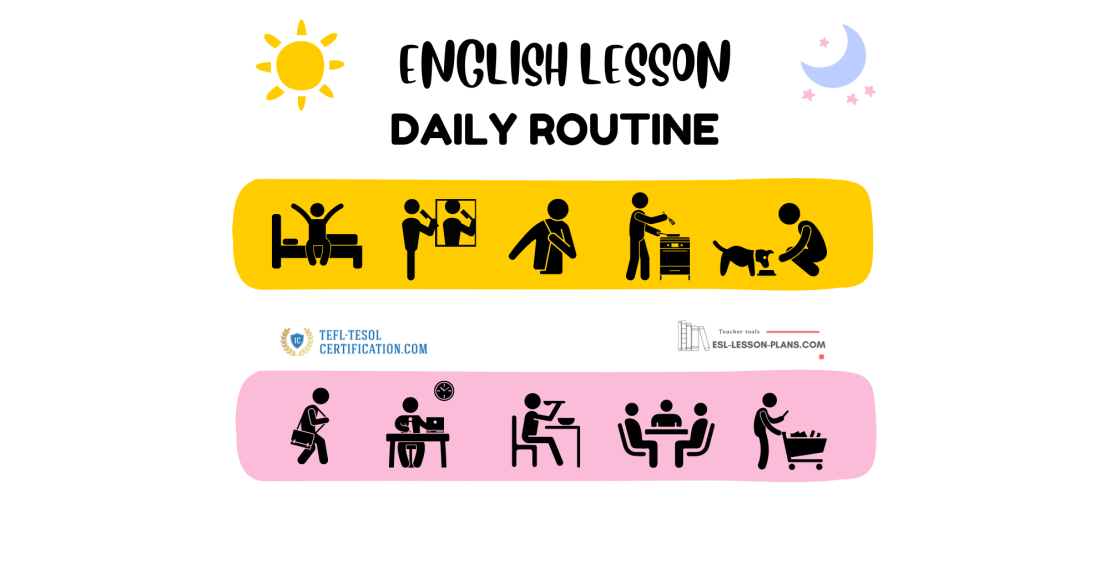
Practicing the daily routine in English classes is an unavoidable foundation that you, as an experienced teacher, may occasionally find unexciting. Nevertheless, its importance cannot be overstated for several reasons. Daily routine English classes serve as the building blocks for students to amass their basic vocabulary, comprehend the rules of sentence construction, identify nouns and verbs, and grasp the fundamental concepts behind different verb forms. These lessons form the bedrock of students' ability to speak and comprehend the English language.
As an EFL and ESL teacher, it is your responsibility to ensure that lessons revolving around the daily routine topic are engaging and captivating for your students. This article aims to assist you in making these lessons as effective as possible.
Get your TEFL TESOL certification
Travel, work online, get a job abroad, or be
an EFL and ESL teacher in your country.
A great starting point is to introduce an example of a planner. Given the rising popularity of planning habits nowadays, students are likely to be familiar with this technique. Begin by providing an example of a daily planner and then collaboratively create a plan of the day for a perfectly goal-oriented person along with your students.
Below are some examples of what such plans might look like:
1st Example of Daily routine:
6:00 AM - 6:30 AM: Morning meditation and stretching
6:30 AM - 7:00 AM: Healthy breakfast and planning the day's tasks
7:00 AM - 8:30 AM: Gym workout and physical exercise
8:30 AM - 9:00 AM: Quick review of English vocabulary and phrases
9:00 AM - 12:00 PM: Work on important projects and tasks
12:00 PM - 1:00 PM: Lunch break with English conversation practice
1:00 PM - 3:00 PM: Attend English language workshop or online class
3:00 PM - 4:00 PM: Creative hobby or skill development with English instructions
4:00 PM - 5:00 PM: Review and revise important grammar concepts
5:00 PM - 6:30 PM: Personal time for relaxation and leisure activities in English (reading, watching movies, etc.)
6:30 PM - 7:30 PM: Cooking dinner while listening to English podcasts
7:30 PM - 8:30 PM: Family time with English board games or conversations
8:30 PM - 9:30 PM: Wind down with English reading or writing in a journal
9:30 PM onwards: Prepare for a good night's sleep with a bedtime story in English
2nd Example of Daily routine:
7:00 AM - 7:30 AM: Morning jog while listening to English audiobooks or podcasts
7:30 AM - 8:00 AM: Healthy breakfast with English news or articles
8:00 AM - 12:00 PM: Attend English language classes or online lessons
12:00 PM - 1:00 PM: Lunch break with English conversation practice with classmates
1:00 PM - 3:00 PM: Group study session focusing on English grammar and vocabulary
3:00 PM - 5:00 PM: Engage in language exchange with native English speakers online
5:00 PM - 6:00 PM: Relax with an English book or TV series
6:00 PM - 7:30 PM: Join an English-speaking club or attend a language meetup
7:30 PM - 8:30 PM: Prepare and enjoy dinner while practicing English cooking terms
8:30 PM - 9:30 PM: Practice pronunciation and intonation with English speech exercises
9:30 PM onwards: Free time for personal interests, chatting with English-speaking friends online, or further reading in English.
Remember, the key is to customize the plans to suit your students' interests and proficiency levels, making the learning experience both productive and enjoyable.
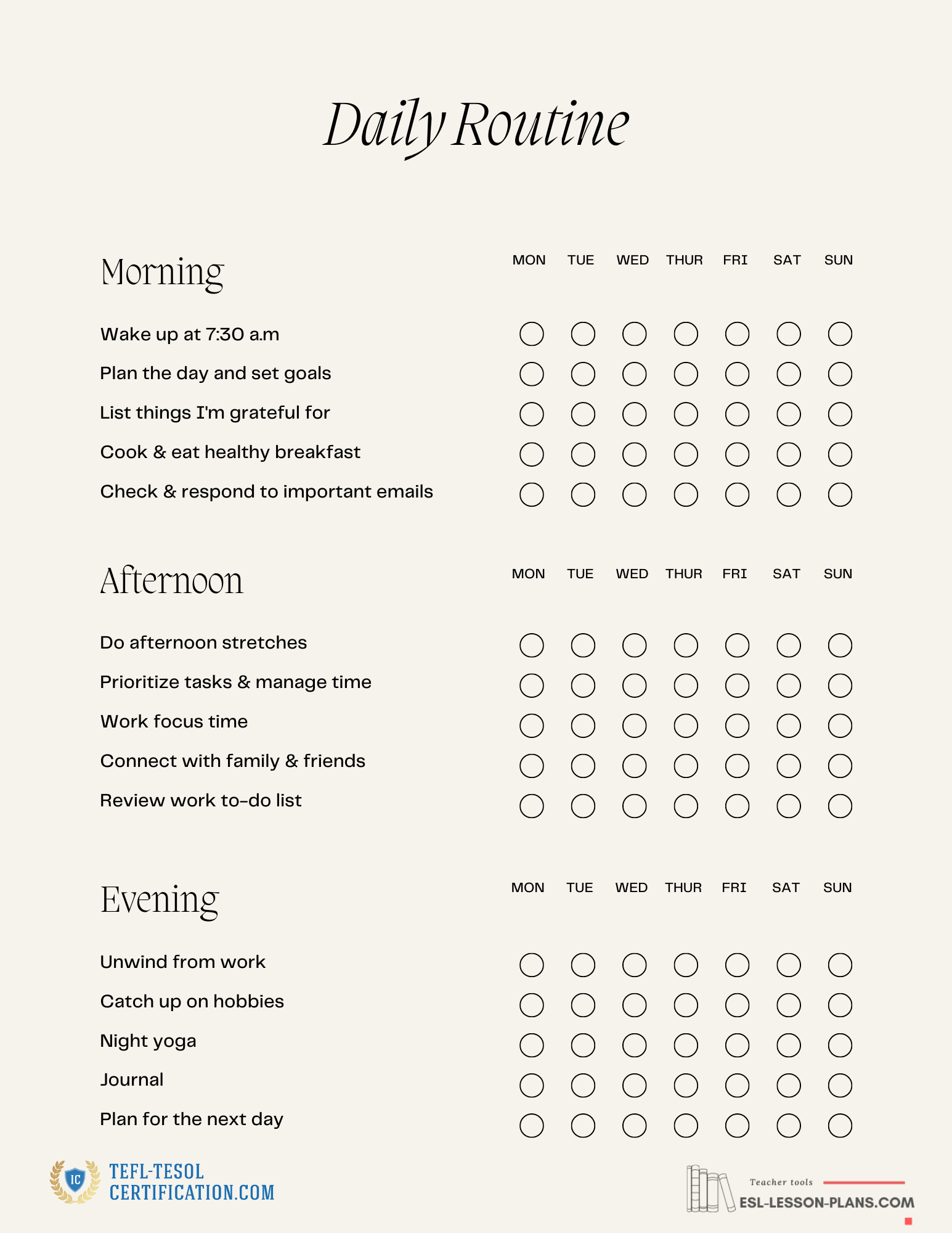
![]()
Below are several planners that you can fill out together with your students.
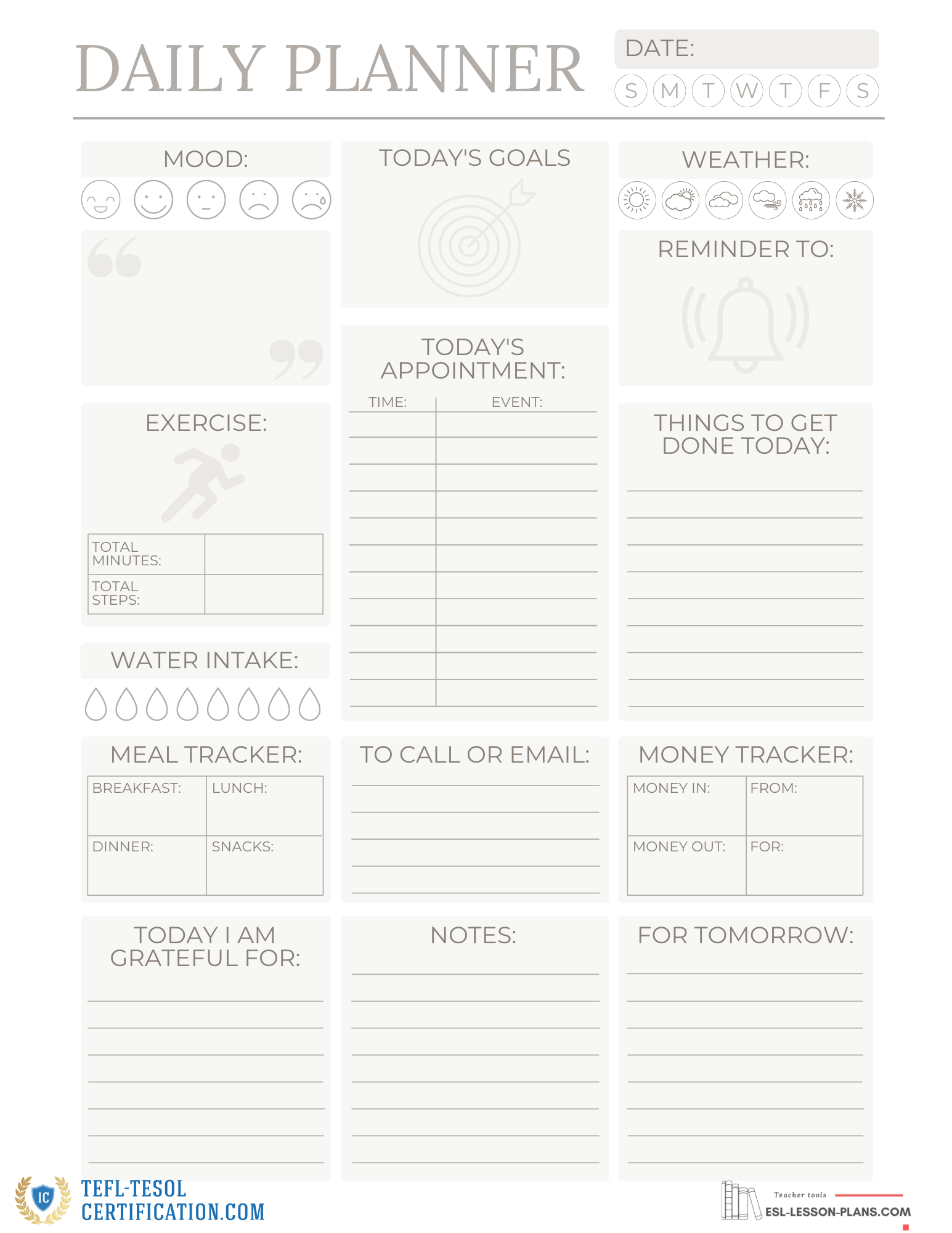
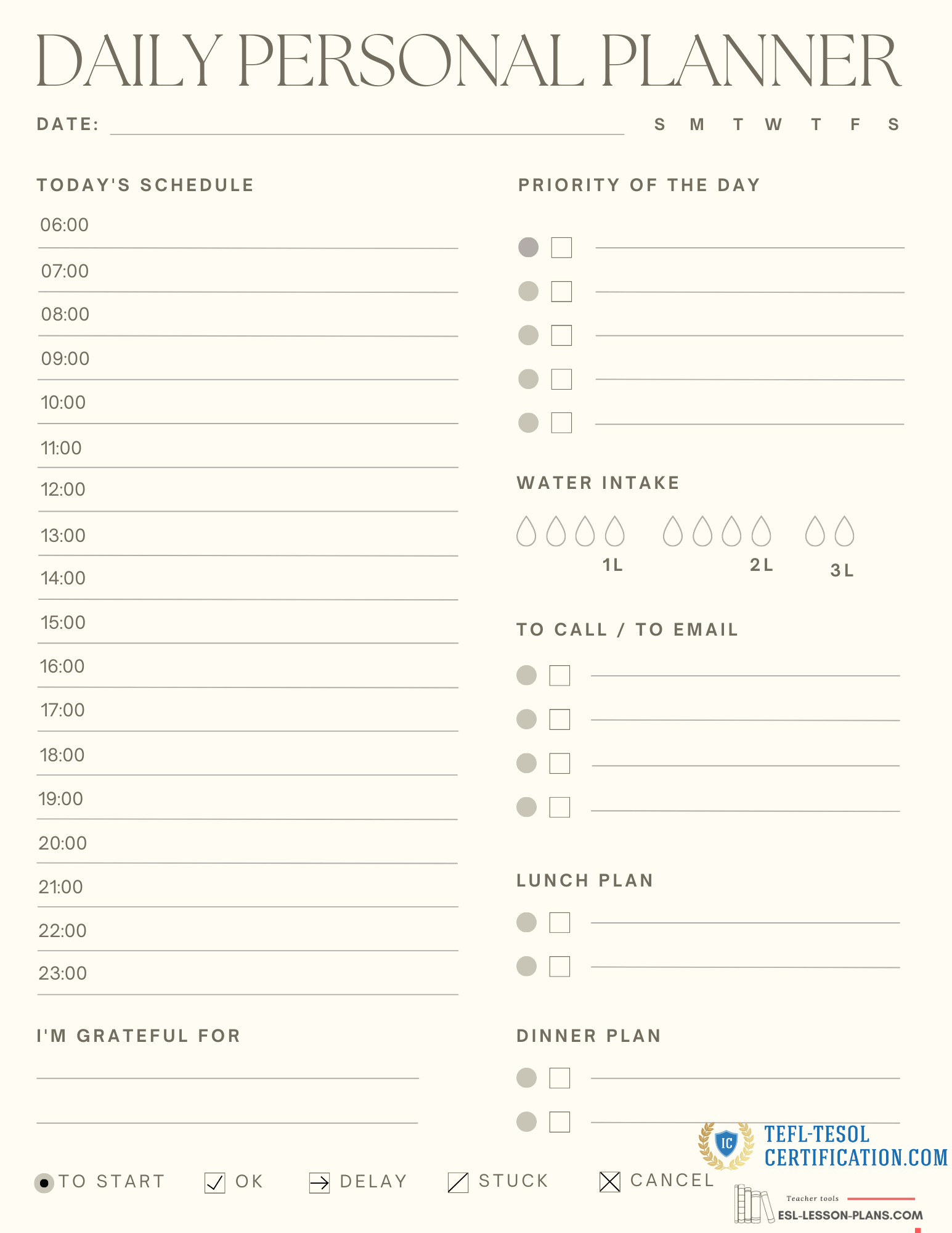
Essential words and phrases to practice.
Morning Actions and morning time vocabulary:
- Wake up
- Get up
- Get ready
- Make the bed
- Take a shower
- Take a bath
- Comb your hair
- Brush your hair
- Brush your teeth
- Put on makeup
- Get dressed
- Make and eat breakfast
- Meditate
- Practice yoga
- Go for a jog
- Go to gym
- To have brunch
- To have a cup of coffee/tea/orange juice
- Go to work
- Go to school
- Go to university
- Early morning
- Sunrise
- Dawn
- Mid-morning
- Late morning
- At + specific time
- On + date or day of the week
- In + month or year
Afternoon actions:
- At noon
- Lunch break
- Lunch hour
- Happy hour
- Eat lunch
- Go out to eat
- Get off work
- Leave school
- Go out for dinner
- Go out for drinks
- Go home
- Get home
- Study
- Hang out
- Relax
- Do homework
- Workout
- Exercise
- Make dinner
- Feed the dog/the cat
- Run errands
- Do chores
Evening time vocabulary and actions:
- Sunset
- Twilight
- Dusk
- Eat dinner
- Watch TV
- Watch a movie
- Go out
- Write a journal
- Reed a book/magazine
- Scroll social media
- Procrastinate
- Play video games
- Chill out
- Take the rubbish out
- Wash the dishes
- Take medication
- Get in the pyjamas
Night time vocabulary and actions:
- Midnight
- Get ready for bed
- Skin care routine
- Get things ready for the next day
- Set an alarm
- Get in bed
- Go to bed
- Go to sleep
- Sleep tight
- Fall asleep
- Turn off the lights
When explaining unfamiliar words to your students, always provide context. Aim to minimize Teacher Talking Time (TTT) and increase Student Talking Time (STT). Encourage students to ask as many questions as possible and create an environment where they feel comfortable making mistakes during the lesson. When you begin teaching a new group of students, let them know that your class is a safe space for making mistakes, and it's better to make those mistakes with you so you can correct them and help them become more proficient English speakers in the real world. Assure your students that making mistakes is a natural part of learning, and it's one of the best ways to improve. Remind them that only those who do nothing make no errors.
To foster confident English-speaking skills in your students, provide guided practice. One effective method is to have them fill in the blanks or apply necessary words in exercises. This type of practice will support their language development and reinforce their understanding of new vocabulary and grammar concepts.
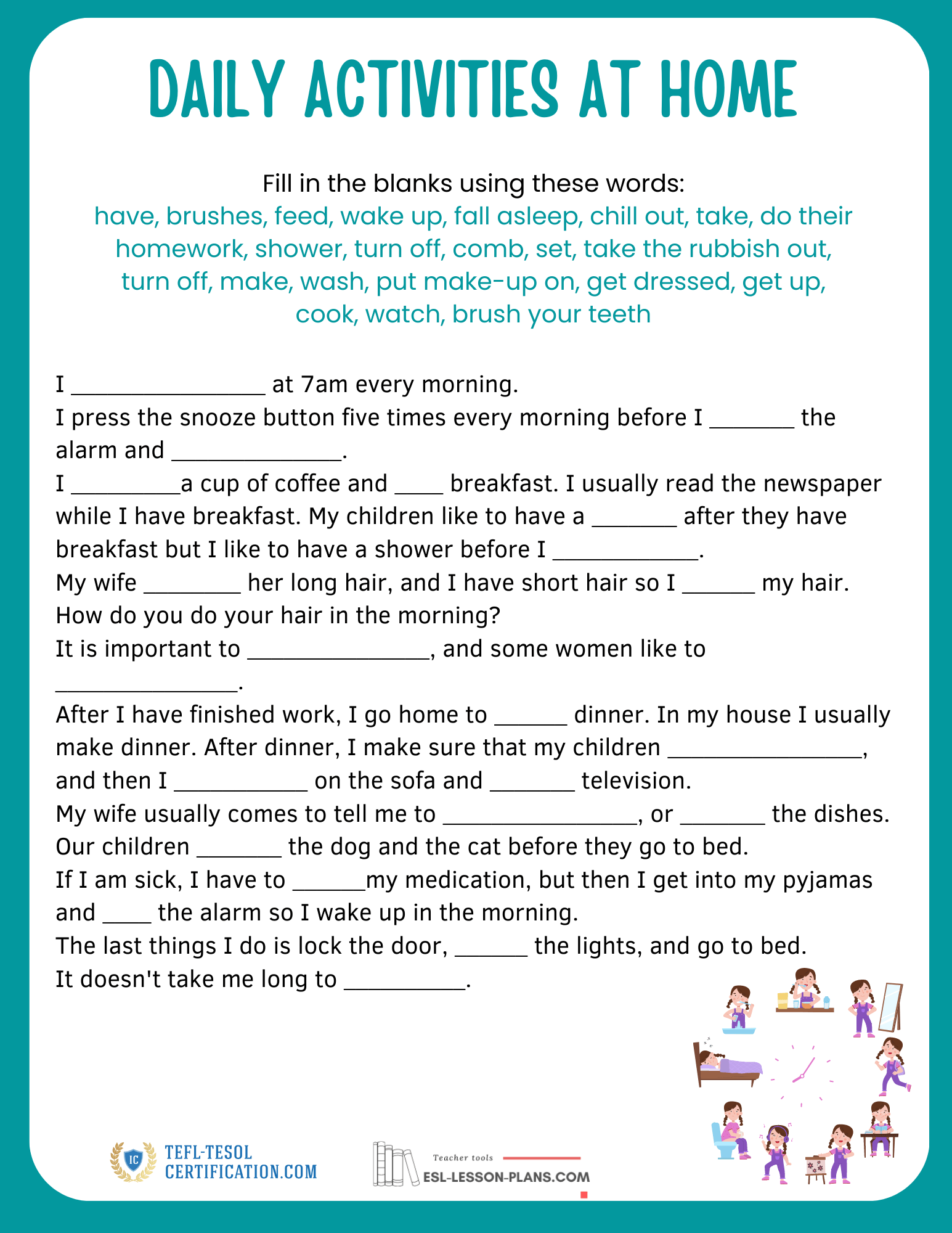
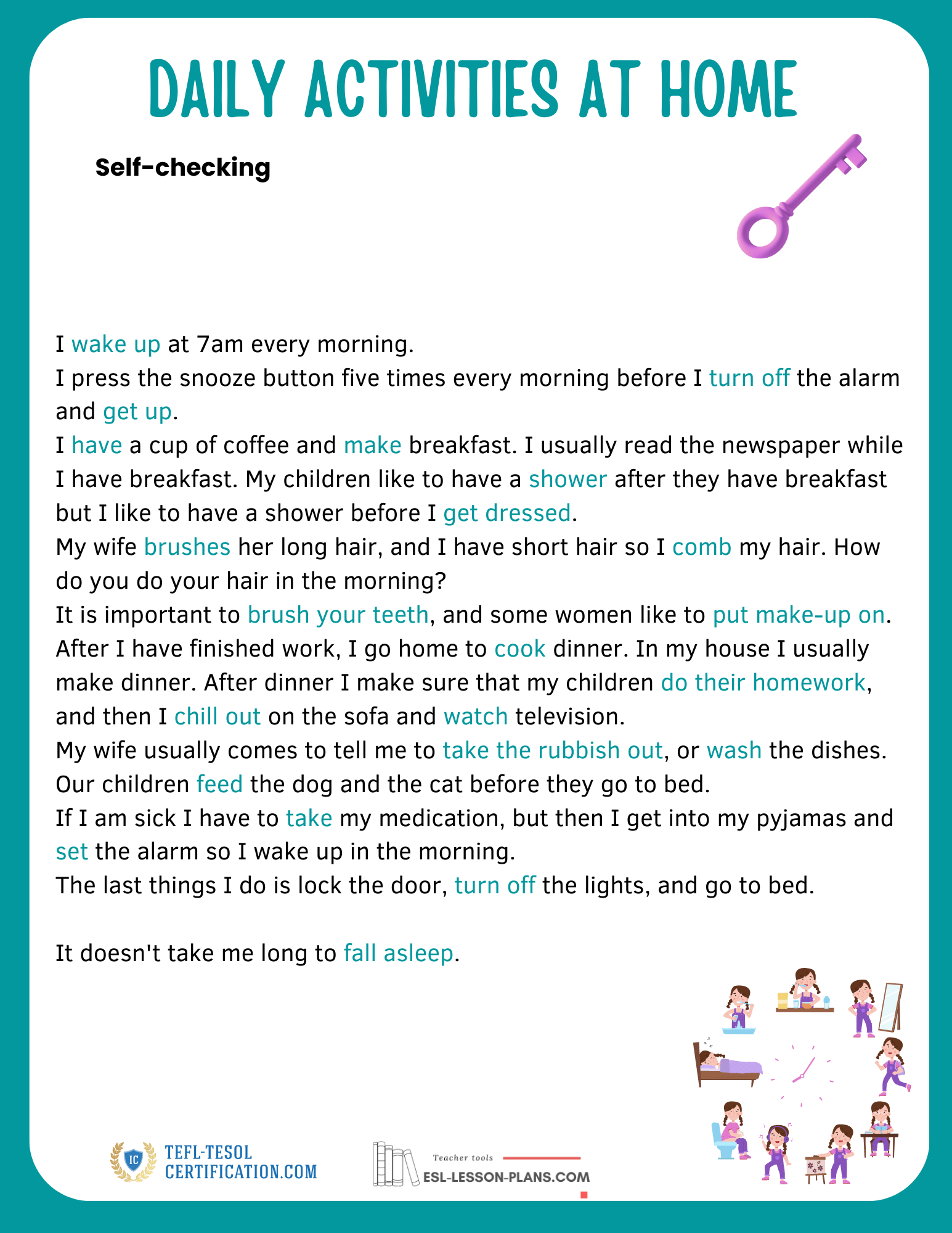
When introducing the "Daily Routine" topic, it's crucial to include the rules of using correct prepositions for time and places. Allocate sufficient time to cover this essential aspect thoroughly. Keep in mind that you are responsible for establishing a strong foundation in English language learning.
Talking About Location
Use at with a general location or an idea
- at work
- at the office
- at home
- at school
- at the beach
Use in if you’re inside or contained within something bigger
- in my house
- in the office
- in a restaurant
Use on if you’re touching something or on the surface
- on the second floor
- on the beach (walking on the sand, but not in the water)
- on the floor
- on the roof
- on the moon
- on an island
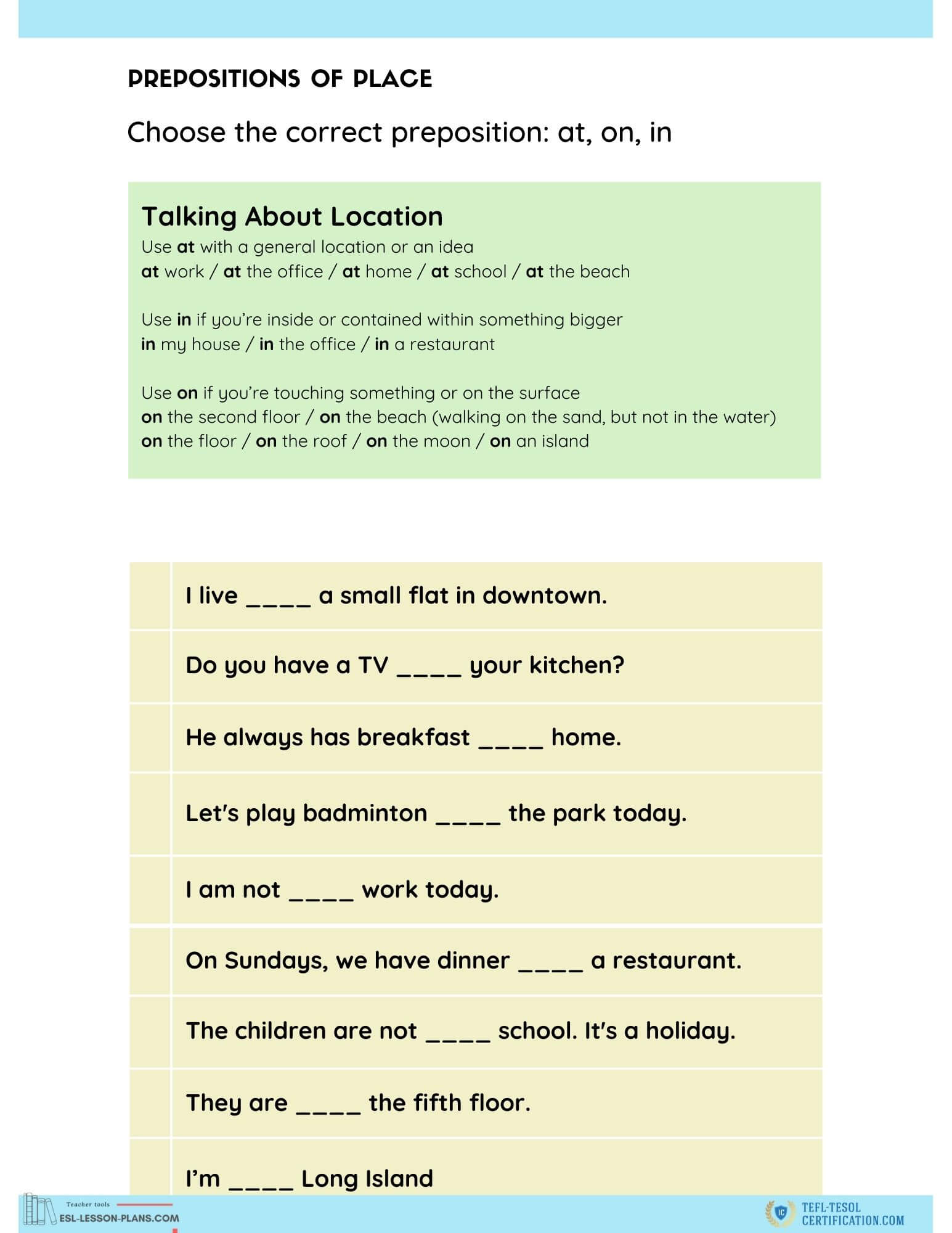
Talking About Time
Use on with specific days
We’ll meet on Tuesday, or maybe on August 15th.
Use in with longer periods of time like months, years, and parts of the day
We can go in December, in 2024 or in the 21st century.
Use at for exact times and with night
I’ll call you at 8:30 p.m.
Let’s meet at noon.
Use at with night in most cases:
He comes home at night.
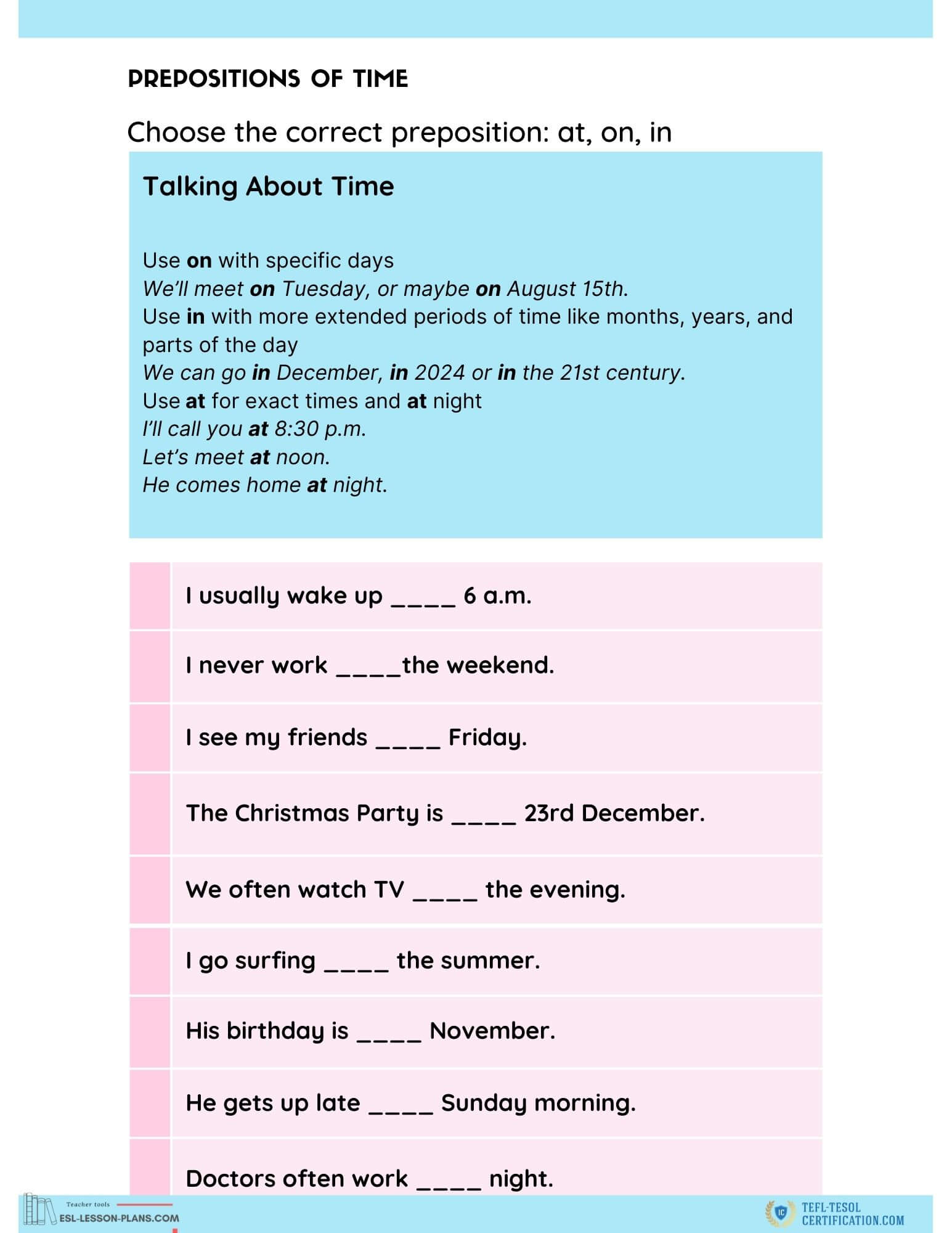
Once students have grasped the main concepts of utilizing prepositions of time and place correctly, constructing sentences with proper subject-verb order, and forming coherent structures, it is time to move on to practicing communication skills by applying the newly acquired knowledge.
However, before diving into independent speaking practice, provide them with some semi-guided exercises. For instance, have them create sentences using mixed-up words to reinforce their understanding and application of the material. This semi-guided practice will serve as a valuable bridge to more independent speaking activities later on.
- starts, he, at, work, o’clock, eight, his.
He starts his work at eight o’clock.
- at, gets up, has, early, breakfast, he, and, 7 o’clock.
He gets up early and has breakfast at 7 o’clock.
- usually, home, on, he, stays, Wednesday, at.
On Wednesday he usually stays at home.
- likes, she, in, the, to sit, garden, the, evening, in.
In the evening she likes to sit in the garden.
- park, they, in, on, the, play, Saturday, football.
They play football in the park on Saturday.
- is, on, his, floor, the, office, second.
His office is on the second floor.
- and, the, we, snowboarding, go, winter, skiing, in.
We go skiing and snowboarding in the winter.
- and, do, ten, I, the, then, to, my, bed, homework, at, in, evening, I, o’clock, go.
I do my homework in the evening and then I go to bed at ten o’clock.
- his, after, he, he, night, to, likes, gets, pyjamas, read, teeth, at, brushes, and, into, his.
He likes to read at night after he brushes his teeth and gets into his pyjamas.
- my, are, is, when, at, children, stay, at, husband, school, I, home, and, work, at.
When children are at school, my husband is at work and I stay at home.
Allocate the majority of the lesson time to speaking practice as it is the key to building students' confidence and enhancing their language abilities through practical application.
For larger classes, it is advisable to divide students into pairs for more effective communication and to maximize Students' Talking Time. While they engage in the speaking activity, make sure to monitor their progress and participation.
When setting the task, ensure clarity so that all students understand it from the initial explanation. For instance, you can assign specific roles within each pair, where Student A asks questions, and Student B provides clear responses. The objective of these questions is to collaboratively create a planner. To aid this activity, you can distribute worksheets for them to fill out during the exercise.
Provide students with sample questions and answers for practice.
Example:
A: What time do you wake up?
B: Usually I wake at 6 a.m. but on Sundays I get up at 9 a.m.
A: What is your morning routine?
B: I take a shower, brush my teeth, do exercises, make a breakfast, listen to music, write a journal, etc.
Once B Student’s planner has been completed, it's time to switch roles. Student B will now take on the role of the questioner, asking questions to Student A, who will provide answers. Student B will then fill out the planner for Student A based on the responses.
For evaluation purposes, you can ask each student to summarize or highlight some key points from the planner they filled out. As you've monitored the activity, you may have made some notes and noticed common mistakes. This is an opportune moment to reiterate the rules and clarify any misconceptions for the benefit of all students.
Get your TEFL TESOL certification
Travel, work online, get a job abroad, or be
an EFL and ESL teacher in your country.
For homework assignments, strive to provide interesting and engaging tasks. For example, students can watch a YouTube video, jot down unfamiliar words and phrases, and discuss them during the next lesson. This approach allows you to receive valuable feedback from the students and gain insight into their progress and understanding of the material.
